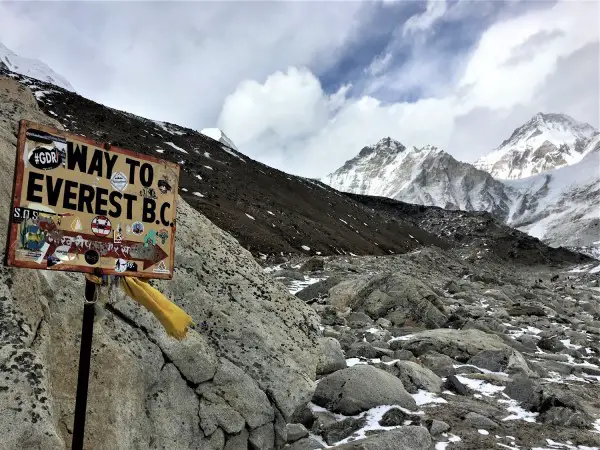
Everest Base Camp trek is a 12-day spectacular journey that brings you into the heart of the Himalayas. If you add a few extra days to your itinerary, you can conquer not one, but two stunning base camps during your trek. The base camp of the highest mountain in the world – Mt. Everest – as well as the base camp of the most beautiful peak in the Khumbu region – Ama Dablam.
This detailed itinerary with distances, practical tips and accommodation suggestions will help you to plan your own adventure. You’ll see that although Mount Everest is the highest mountain in the world, organizing a base camp trek is easier than you think!
But if you are still unsure about the Everest Base Camp trek, have a look at “EVEREST BASE CAMP OR ANNAPURNA CIRCUIT – WHICH TREK TO CHOOSE?”
IMPORTANT UPDATE: On 9 March 2023, the Nepal Tourism Board (NTB) announced that foreigners, whether solo or in a group, will no longer be allowed to trek in Nepal without a guide. From April 1, all hikers must be accompanied by a licensed guide. Read about the new rule here: BAN ON TREKKING IN NEPAL WITHOUT THE GUIDE – HAS THE RULE COME INTO FORCE? – UPDATE FROM THE TRAILS
What's in this blog post?
How many days do you need to complete the Everest Base Camp trek?
The minimum number of days
The minimum number of days required to complete the 130 km round trip to Everest Base Camp is 12 days. Usually, reaching the base camp takes 8 days and you need 4 more days to return.
A 12 day itinerary consists of 9 days of intensive trekking, 2 acclimatization days – the absolute minimum to get acclimated to altitude and 1 day to return by plane to Kathmandu. Flights from Lukla take place only in the mornings, so a separate day is needed for this. In this 12-day route, there is no room for a stumble or an extra rest day. Completing Everest Base Camp trek in less than 12 days is risky.
It might seem that this relatively short route could be completed faster. Walking an average of 11 kilometers a day is not much. You couldn’t be more wrong. More rapid increase in altitude may end up with altitude sickness. Even if you feel well at that particular moment, you should not skip the acclimatization day as it helps you to feel good also at higher altitude. On the contrary, you may need to have 1 or 2 spare days in case your body takes longer to adjust to the less oxygen in the air or for any potential delay.
To learn more about the risk of altitude sickness please read my blog post ““DANGERS WHILE TREKKING AND HOW TO AVOID THEM”“.

The Everest Base Camp trek in 12 days
The way up (6 days of ascent + 2 acclimatization days)
1. Monjo / Phakding – 2. Namche – 3. Namche (acclimatization) – 4. Tengboche – 5. Dingboche – 6. Dingboche (acclimatization) – 7. Lobuche – 8. EBC Gorak Shep
The way down (3 days of descent + 1 day for a flight to Kathmandu)
9. Pheriche – 10. Namche – 11. Lukla – 12. Kathmandu
The recommended number of days
When planning a trek in the Himalayas you should always have a few extra days because:
- You don’t know how quickly your body will acclimate to altitude and might need more time to adjust.
- You can’t predict the weather. The weather conditions in the mountains can change rapidly. I hate walking in the rain and fog, where I can’t see anything. Besides, trekking in bad weather at high altitude can be very dangerous.
- The Himalayas are fabulously beautiful. And who likes to rush in paradise? There are many additional, less traveled, very interesting trails and places to visit outside the main route. It’s worth checking them out. It is the journey, not the destination that matters.
- After all, trekking in the Himalayas is your holiday and when planning a vacation, you should include time for… rest.🙂
Therefore, my proposed Everest Base Camp trekking itinerary consists of 15 days instead of the minimum 12 days. It allows for an additional day to climb, descend and acclimatize, and gives you the opportunity to climb not only Everest Base Camp, but also another base located at the foot of one of the most beautiful in the world – Ama Dablam as part of a 1-day acclimatization hike.
If you only have around 10 days, you might want to choose a different and shorter route. Beautiful treks like Annapurna Base Camp trek or Mardi Himal trek might be better options for you. Read more:
DAY 1. Kathmandu > Lukla > Monjo 2,840m (13km)
Early morning flights tend to have the best chances to take off. The weather in Lukla often worsens in the afternoon, which results in flight delays or even cancellation. It’s best to opt for the first available flight in the morning, usually taking place around 6 am. The flight takes only about 30 minutes, so you will have plenty of time for trekking on the first day of your adventure.
To be blown away by the beauty of the Himalayas as quickly as possible, sit on the left side of the plane on your way to Lukla to enjoy the best views. Tickets do not have designated seats. After arrival, you might want to go for a good coffee and a piece of delicious cake at one of the cafes in Lukla. It will be harder to get a decent coffee high in the mountains. It’s probably also a good idea to celebrate a successful landing at the most dangerous airport in the world.:)
The route to Phakding took me 3 hours and turned out to be a very pleasant walk. It was exactly what I needed after an early morning flight. From the very beginning, the scenery was magnificent. You can see not only snow-capped peaks in the distance, but also plenty of picturesque stupas, stone mani walls carved with Buddhist mantras and prayer mills. Phakding is a good place to rest and eat something. It’s still about 2.5 hours to reach Monjo .
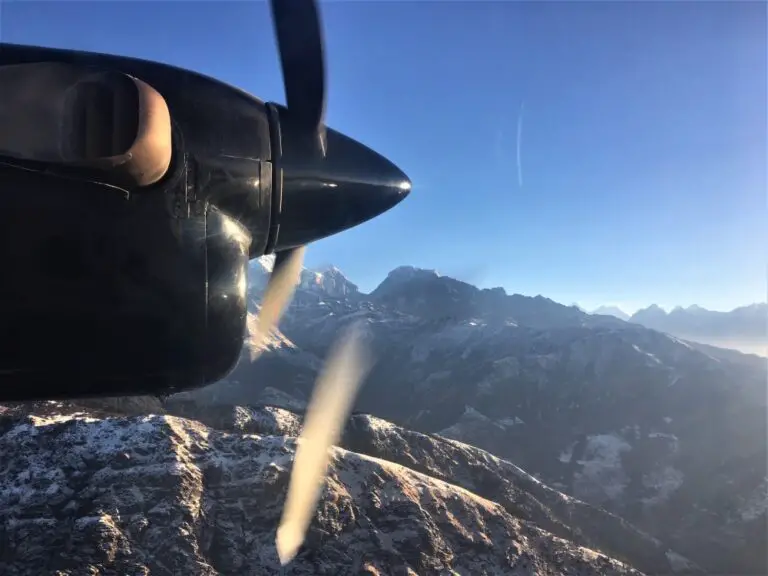
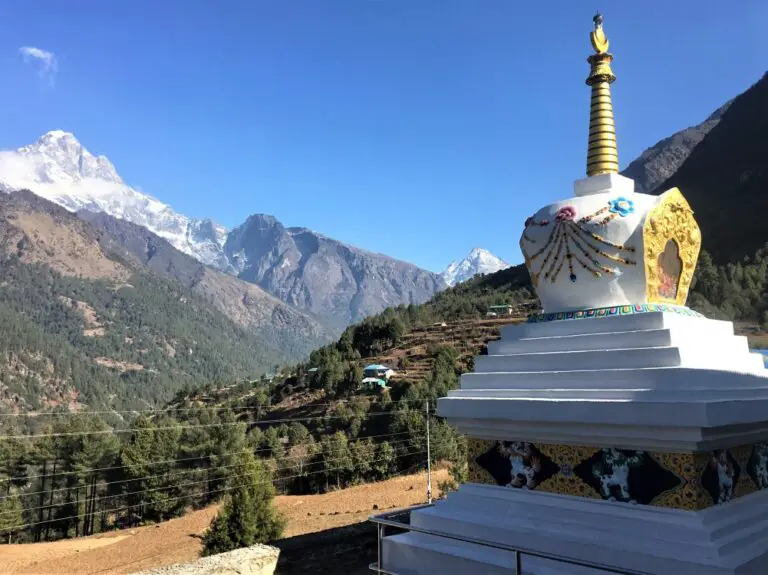
Practical tip
Most people choose to stay overnight in Phakding. However, it’s better to stay a bit further in Monjo, situated 5 km closer to Namche Bazaar. Reaching Monjo on the first day will make your second day much easier. Believe me, the ascent to Namche Bazaar is pretty demanding.
Place to stay in Monjo
At this altitude, the prices are low and the standard is high. There are plenty of good options. I stayed at the Monjo Guesthouse. I got a very nice room with its own bathroom and hot shower for 300 NPR (less than 3USD). What a luxury!
DAY 2. Monjo > Namche Bazaar 3,440 m (6 km)
It’s often believed to be the hardest day of the Everest Base Camp trek. In fact, the 600-meter ascent is not easy for your body, which is not yet used to hiking with a heavy backpack. After leaving Monjo you need to stop and pay for the Sagarmatha National Park permit (3000 NPR, about 25 USD) at the checkpoint. Once you pass Jorsale – the last village before the tough ascent to Namche – the path goes through the forest. In this section, you will have the opportunity to cross the picturesque suspension bridges which are so typical for the Himalayan scenery. There is a first viewpoint where you can spot the Everest summit halfway up on your way to Namche!
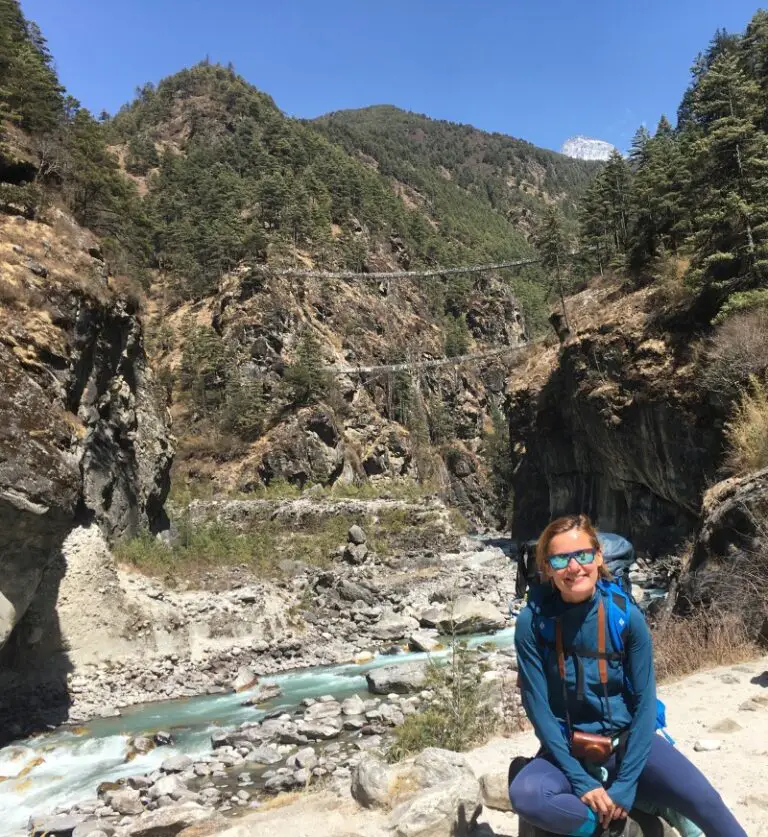
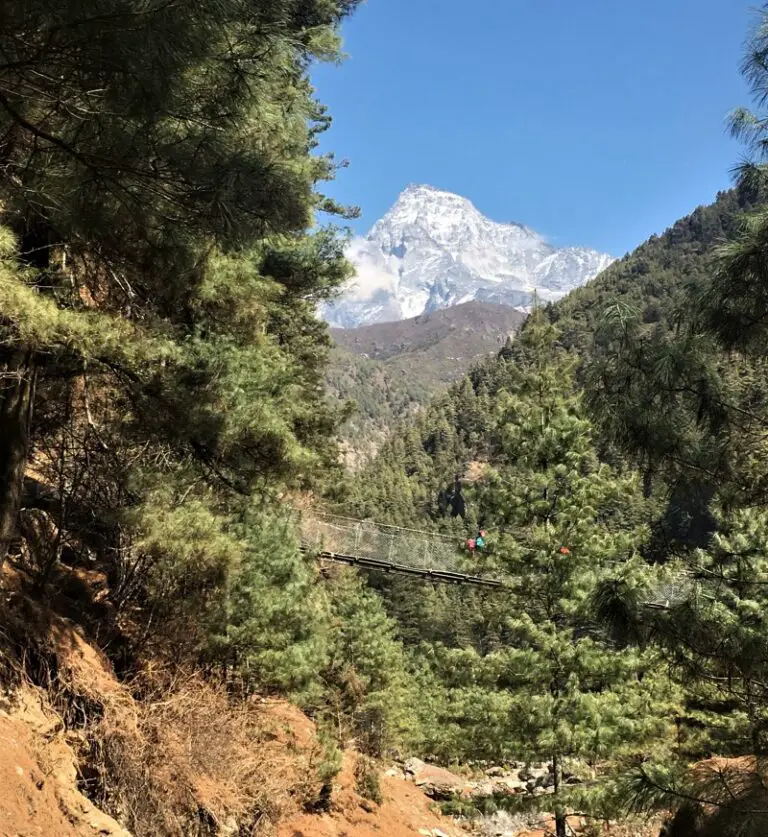
It took me 5 hours to get to Namche and I was very glad to start from Monjo and not Phakding. Namche Bazaar captivates at first sight. How to resist the charm of a picturesque village with narrow cobbled streets, surrounded by beautiful mountains?
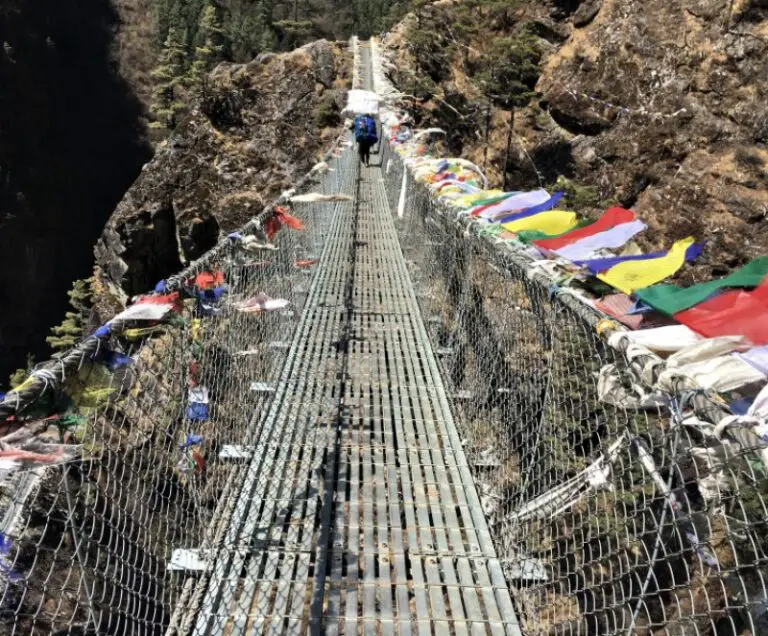
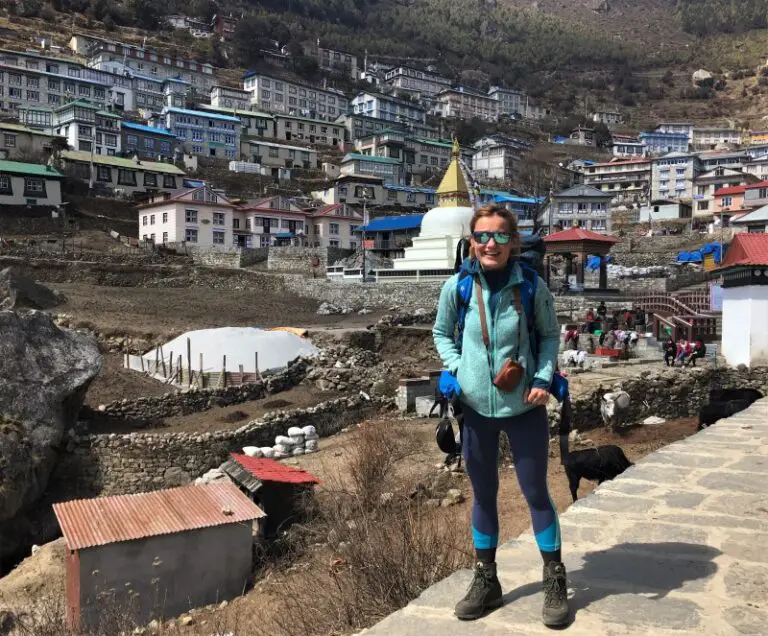
Practical tip
Make sure you have enough water for the whole day of your trek. There are no places to refill or buy water on the 5-kilometer route from Jorsale to Namche.
Place to stay in Namche Bazaar
Starting from Namche Bazaar the room price on the Everest Base Camp trek is fixed and amounts to 500 NPR (~4.5 USD). I stayed at Alpine Lodge because of its beautiful view. It is a very cozy lodge located a little bit higher on a slope with a wonderful view of Thamserku (6,623 m) overlooking Namche Bazaar.
DAY 3. Namche Bazaar > Everest View Hotel 3,880 m > Namche Bazaar 3,440 m via Syangboche, Khunde and Khumjung (6.5 km); 1st acclimatization day
Namche Bazaar is the unofficial capital of Sherpas and the entire Khumbu region. You could easily spend the whole day wandering its charming little alleys, looking for souvenirs and hanging out in cosy bakeries, restaurants and bars. Unfortunately, it would not be a day spent in the right way. To help the body acclimatize to the altitude you should climb higher during the day and return to a lower altitude for the night.
In order to make the best use of the acclimatisation day is to trek to the remarkable villages of Sherpas – Syangboche, Khunde and Khumjung as well as the famous Everest View Hotel. From its terrace with a cup of delicious masala tea in your hand, you will be able to admire the highest mountain in the world. It took me 5 hours to complete this loop but I did it at a very leisurely pace. What’s most important, ascending 400 meters helped with the good acclimatization. If you happen to be in Namche on Saturday, it is worth visiting the local market in the morning. This is where Sherpas coming from nearby villages offer products that may not be very attractive to tourists’ eyes, but the market itself and “parked” yaks nearby are interesting enough to see.
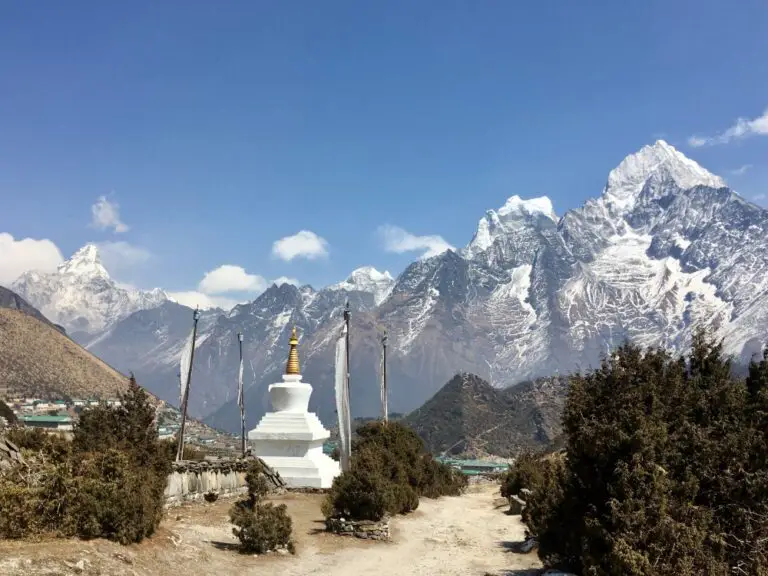
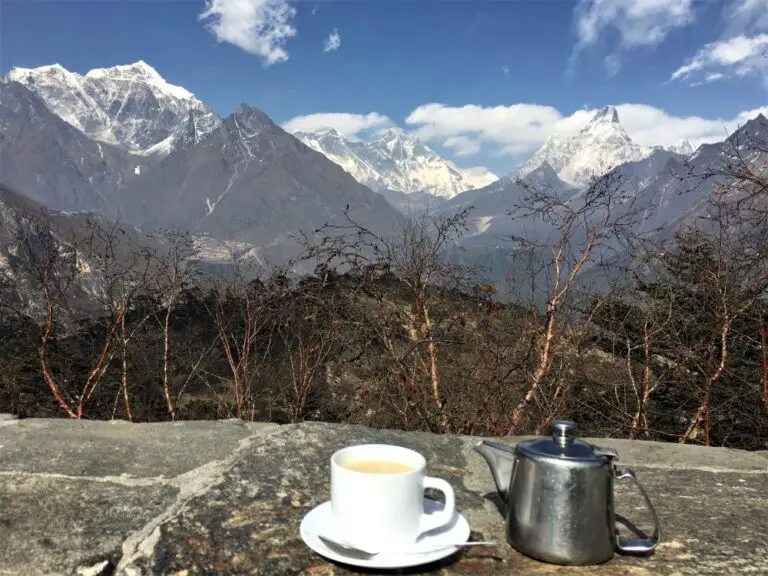
Practical tip
Many people do not experience any altitude sickness symptoms at Namche Bazaar. Feeling great, they skip the recommended acclimatization day and decide not to stay for the second night. That is very wrong! Even if your body feels good today, without proper acclimatization, it might feel the symptoms of altitude sickness tomorrow. In addition, the area surrounding Namche is so beautiful that it is a pity to move forward after only one night.
Second night in Namche Bazaar
Second night at Alpine Lodge. Why change it when it’s good? Also, who wants to pack again?
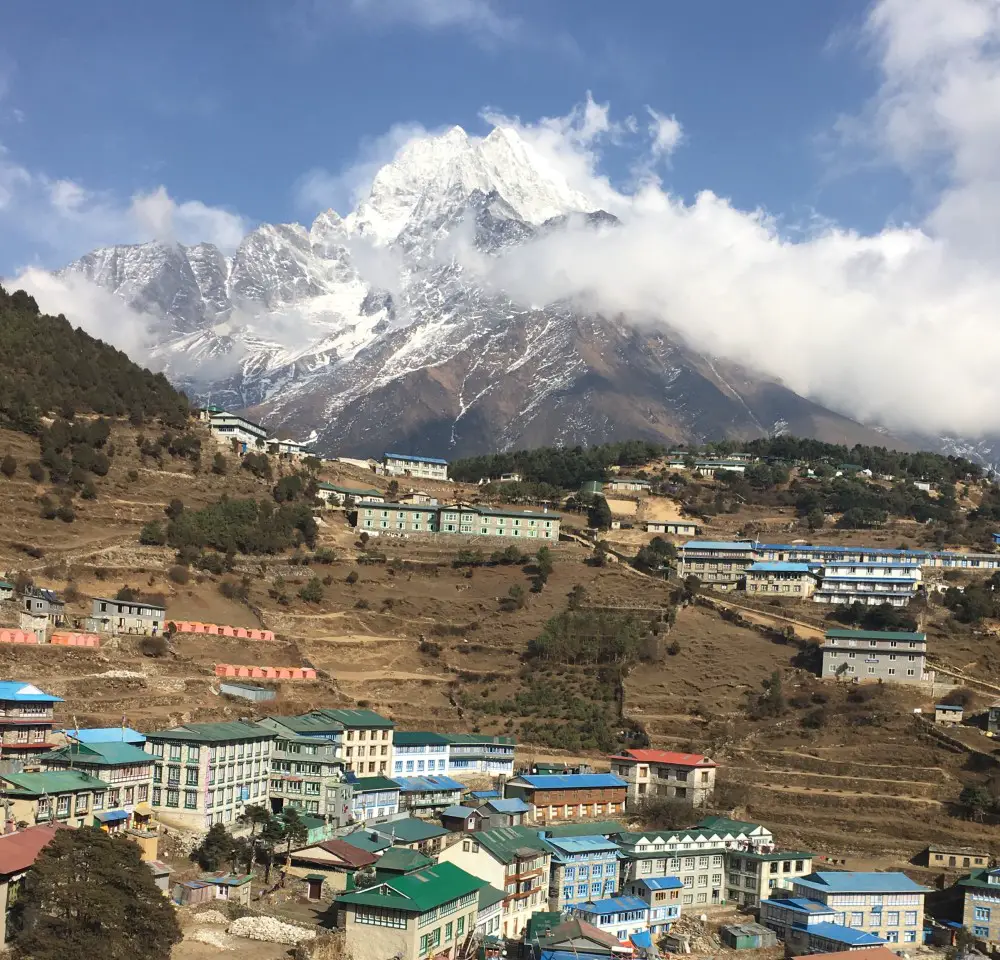
DAY 4. Namche Bazaar > Tengboche 3,860 m (9 km)
After a delicious breakfast in the morning sun with a fantastic view of Namche, I left the lodge rather late – after 9 am. The first part of the trek to Phunki Thenga, which is a great place for lunch, is extremely pleasant (approx. 3 hours). The trail is mostly flat, which is very rare in Nepal, and the views of Ama Dablam (6,812 m), Mt. Everest (8,848 m) and Lhotse (8,516 m) are breathtaking.
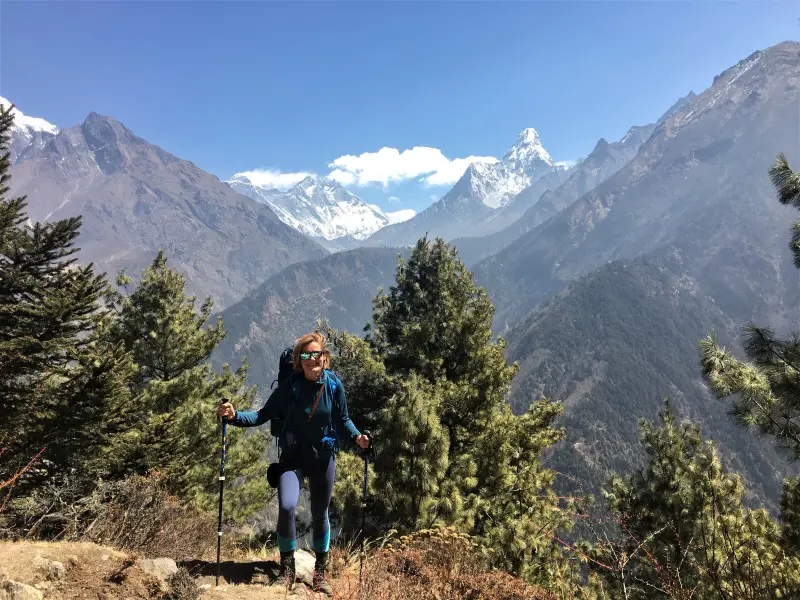
Hiking from Phunki Thenga at 3,250 meters to Tengboche is more demanding though. It took me 2 hours to climb 600 meters. But again, I’m quite slow.

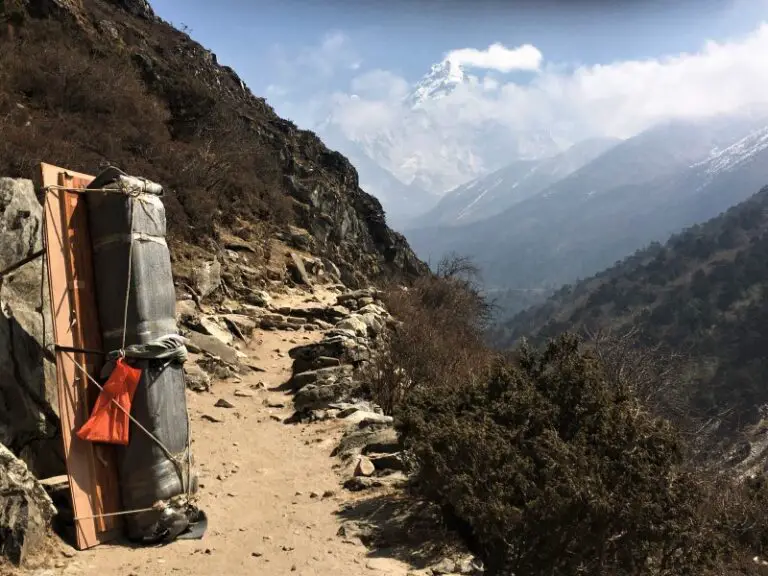
Tengboche is not even a village, but only a cluster of a few lodges. It is built around the Buddhist monastery – a very important site for both locals and climbers planning to climb Everest. The puja ceremonies organized by monks and open to trekkers take place at 6 am and 3 pm in the monastery. No photos during the ceremonies are allowed. Although I didn’t get up early enough to attend the ceremony, I felt the presence of gods while sitting by the monastery surrounded by the amazing the snow-capped peaks of Tawache, Everest, Nuptse, Lhotse, Ama Dablam, and Thamserku. I sat in complete silence and solitude, as all the trekkers rushed very quickly to continue their journey. To experience these magical moments you just can’t rush while trekking in the Himalayas.
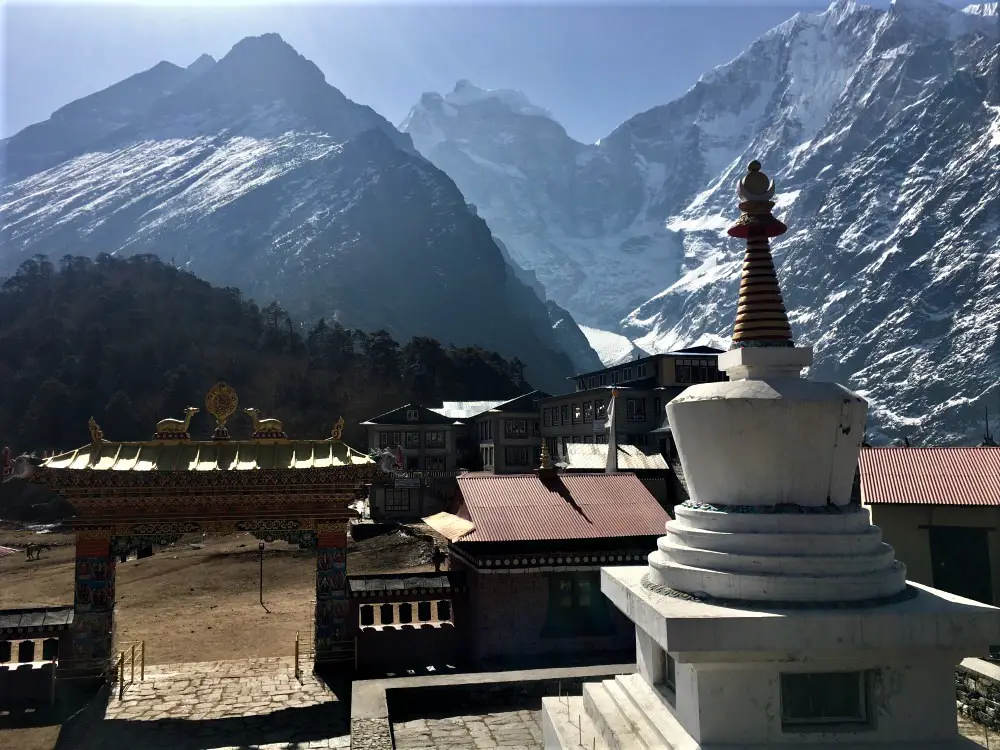
Practical tip
If you don’t like any of the lodges in Tengboche, you can continue the trek for around 20 minutes to Deboche, where you will find some good accommodation options. Especially in high season it may happen that are no available rooms in Tengboche.
Place to stay in Tengboche
The Himalayan Hotel, a very popular option in Tengboche, has a large dining room and fantastic momo tuna dumplings, served with a delicious tomato sauce. It’s worth staying here just for these incredible momos.
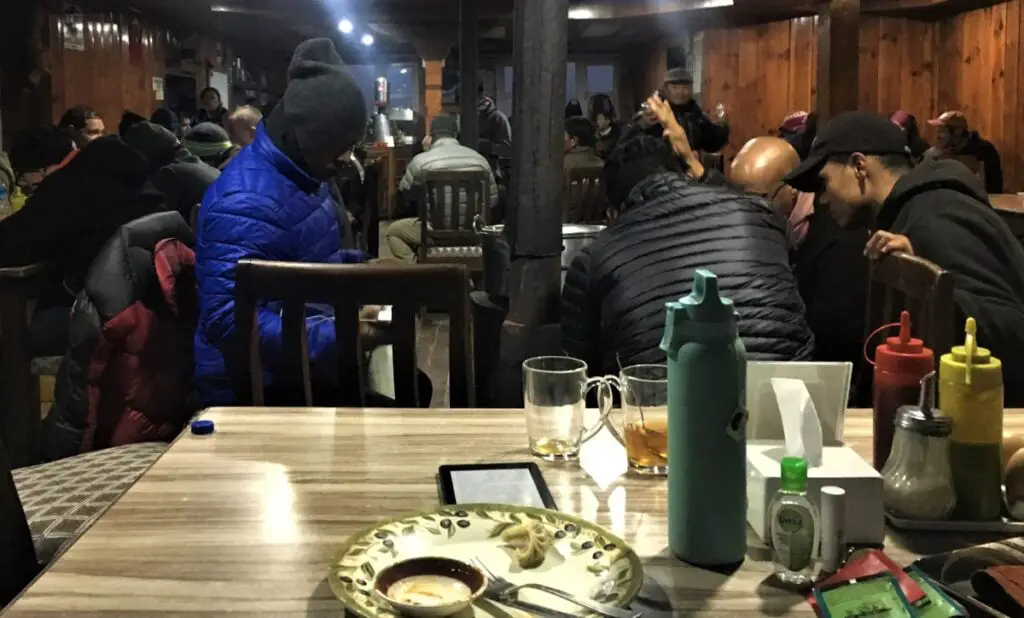
DAY 5. Tengboche > Pangboche 4,000 m (4 km)
It’s a short hiking day. Most people continue to Pheriche or Dingboche, but I decided to stay overnight in Pangboche to head towards the Ama Dablam Base Camp the next day in the morning.
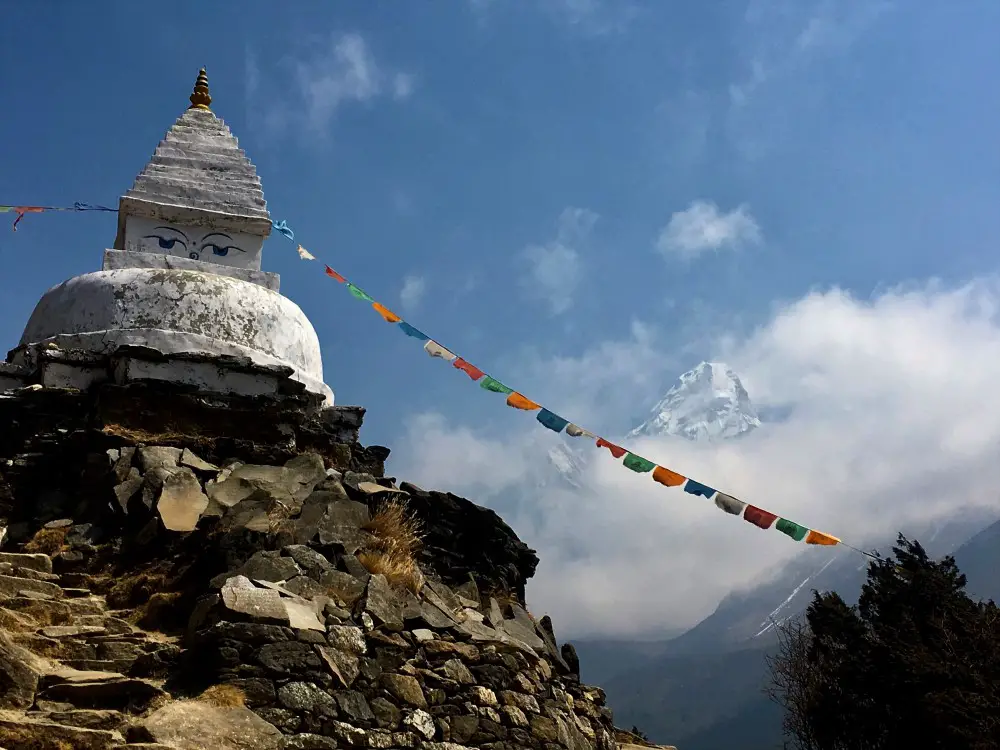
This pleasant and easy route took me 3 hours. As usual, I walked slowly and enjoyed the views. Nevertheless, due to the altitude I arrived at Pangboche very tired.
Practical tip
To make the most out of the rest of the day, I recommend exploring Upper Pangboche, where you can wander around the historic part of the village, where time stood still long ago. The 17th-century monastery is the most famous attraction here. It is not only the oldest monastery in the entire Khumbu region, but the place where the yeti skull is kept! Unfortunately, I was not able to see this remarkable relic with my own eyes, as the monastery was closed.
Place to stay in Pangboche
Wind Horse Inn – I stayed at this lodge for two reasons. First of all, the toilet was located inside the building, in addition very close to my room. This is always extremely convenient considering the amount of liquids consumed during the trek. Frankly speaking, a good toilet location is the main criterion for me when choosing a place to stay. Secondly, there was a beautiful white horse standing in front of the lodge. This is usually not the main factor of deciding where to sleep, but how to ignore it and just walk by?🙂
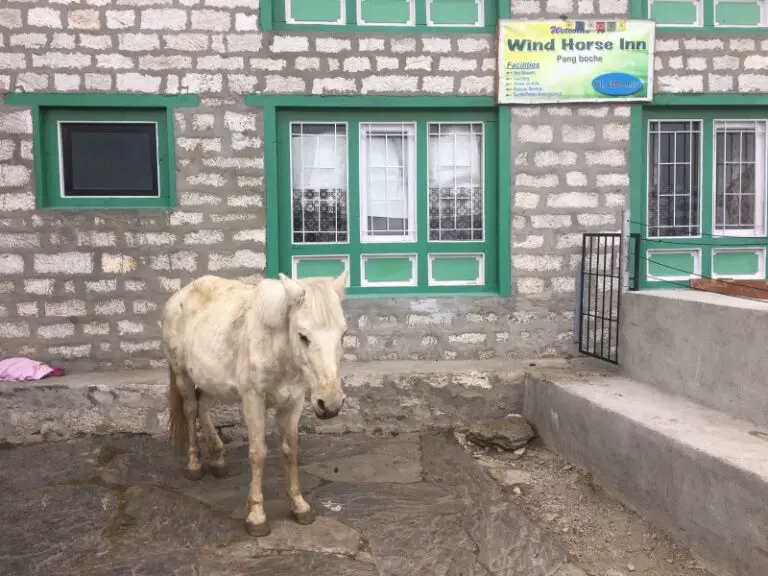
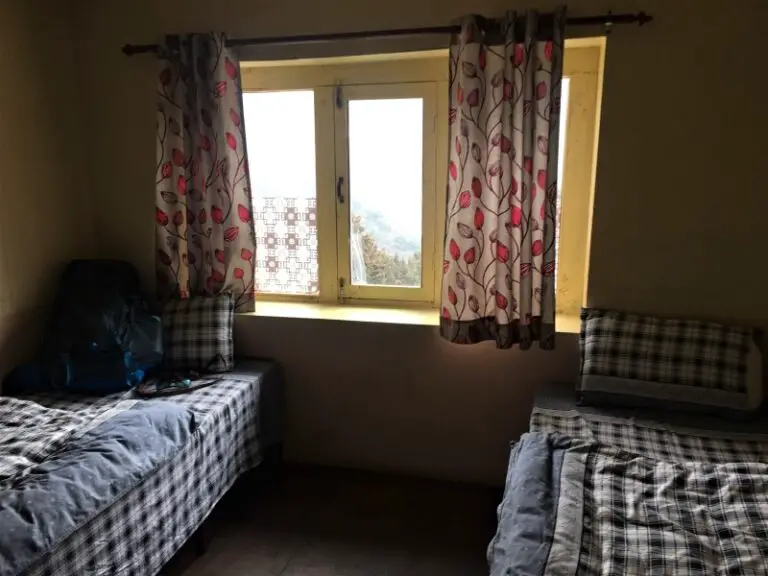
Day 6. Pangboche > Ama Dablam Base Camp 4,600 m > Pangboche 4,000 m (8 km); 2nd acclimatization day
Many people complain that the Everest Base Camp trek is too commercial. The paths are crowded, the villages are not authentic enough because of the lodges built for trekkers. It might be all true, but by planning your adventure properly, you will be able to experience moments when you have the magical Himalayas just for yourself.
The trek to the Ama Dablam Base Camp was stunning. I met no one on my way up. The weather was wonderful and the views were unforgettable. What more could you want? The Ama Dablam Base Camp was of course deserted as March is not the climbing season. I fell in love immediately with the huge plateau located at the foot of the undoubtedly most characteristic peak in the Everest region. Being completely alone and having all this magic just for me was an incredible experience. Ama Dablam (6,812 m above sea level) translates into “Mother’s necklace” thanks to its shape similar to the mother’s arms. It took me 6 hours to climb 600 meters and return to Pangboche, which was a great way to get acclimatized. It wasn’t even that tough.
Second night in Pangboche
Second night at Wind Horse Inn. The white horse was still there.
DAY 7. Pangboche > Dingboche 4,410 m (7 km)
The hike was easy and pleasant. It took me about 3 hours to reach Dingboche. And that’s not the end of good news. Dingboche turned out to be a more interesting and bigger village than expected. It offers plenty of good lodges and nice coffee shops.
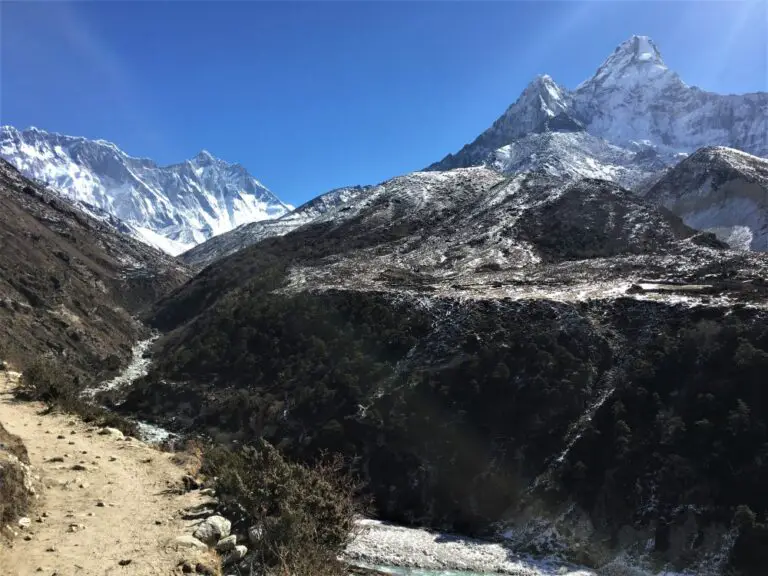
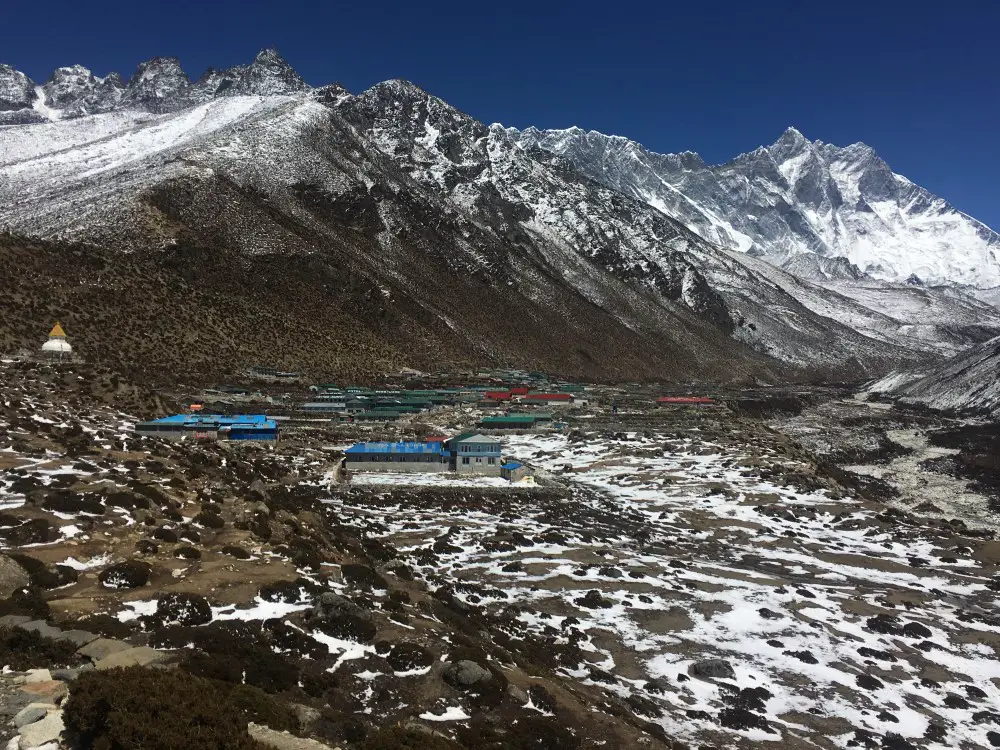
In addition, a mountain-themed movie is projected every day at 2 pm in one of the restaurants! If you don’t feel like hanging out in a cute little Himalayan village though, you can of course spend your time in a more active way. Guess what I’m talking about?! About climbing some mountains for a change!😉
For wonderful views you can try a very popular 1-hour trail leading to the Nangkartshang Chorten, which is decorated with colorful prayer flags.

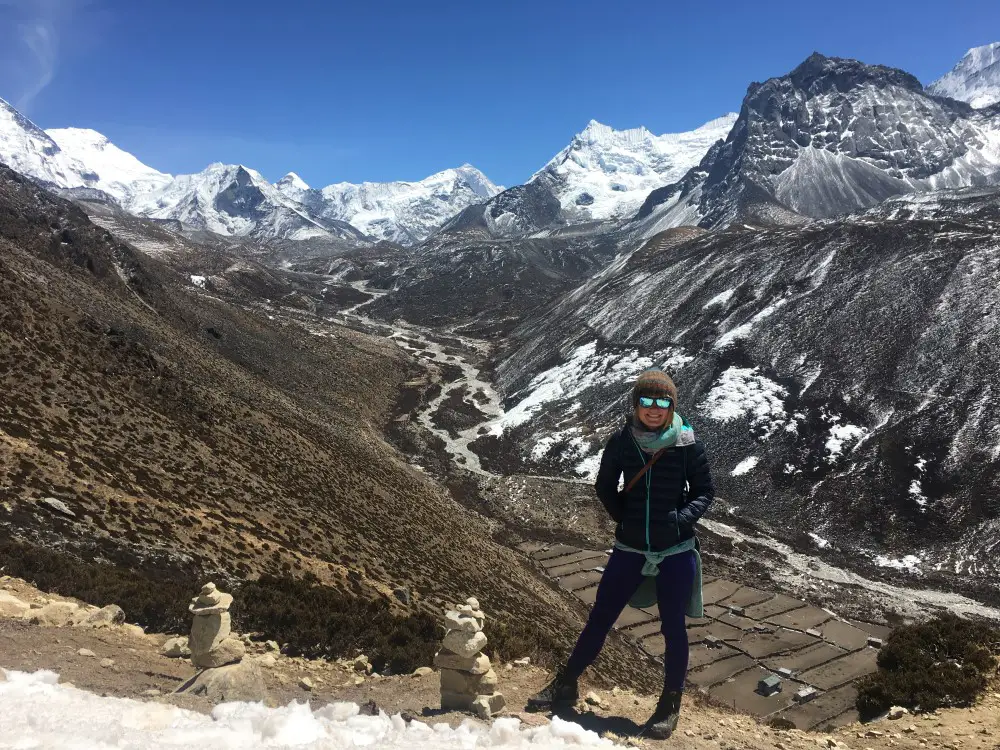
If you are more ambitious, you can continue hiking up to the viewpoint at 5,070 m (about 90 minutes). The panoramic views of Ama Dablam, Chukhung and Makalu (8,463 m) are breathtaking.
Practical tip
If you do not plan the Ama Dablam Base Camp hike, you will probably not stay overnight in Pangboche and head directly from Tengboche to Dingboche. If so, the duration of your trek will be shortened by 2 days. The altitude difference between Tengboche and Dingboche is more than 500 m though, which is a bit too much for one day in terms of good acclimatization. You should avoid climbing more than 400 m a day at the altitude above 3000 m. I recommend doing it, only if you feel well in Tengboche and spent at least 2 nights in Namche. Large and rapid elevation gain may result in very unpleasant symptoms of altitude sickness.
Place to stay in Dingboche
MoonLight Lodge – it is probably the only guesthouse of which I have no special memories during my Everest Base Camp trek. But hey, a lack of memories is better than bad memories. The price for a double room was 500 NPR. It’s definitely not a bad place as a Dutch couple who I met on the trail, moved in from another place for their second night in Dingboche and were much happier in MoonLight Lodge.
DAY 8. Dingboche > Chukhung 4,730 m > Dingboche 4,410 m (9 km); 3rd acclimatization day
If you haven’t stayed overnight in Pangboche, you should stay for the acclimatization day in Dingboche. Even though hanging out in a cosy cafe or watching movies is extremely tempting, that’s not what you came for to the Himalayas. You will not regret hiking up to Chukhung. Although it is supposed to be an easy and short route, walking was not easy at all for me. At this altitude, with less oxygen in the air you don’t need much to feel tired. Probably that’s why my backpack seemed so heavy.
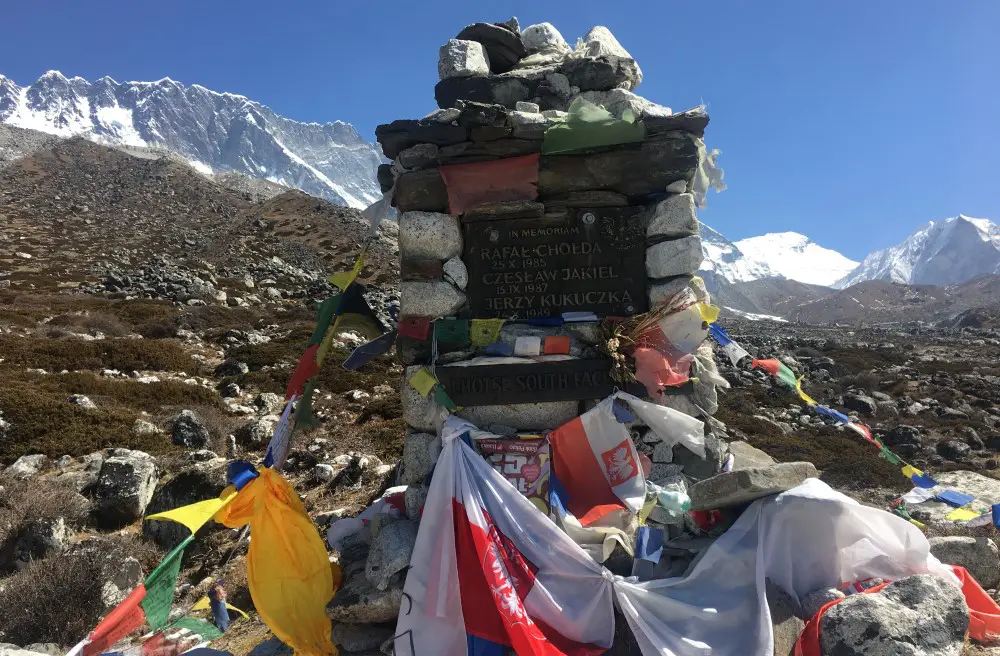
Practical tip
It all depends on whether you have enough strength and time. But if you do… I highly recommend hiking to Chukhung Ri, rising to 5,550 m. It’s not only a great way to acclimatize, the views of Ama Dablam, Island Peak and Makalu are truly amazing!
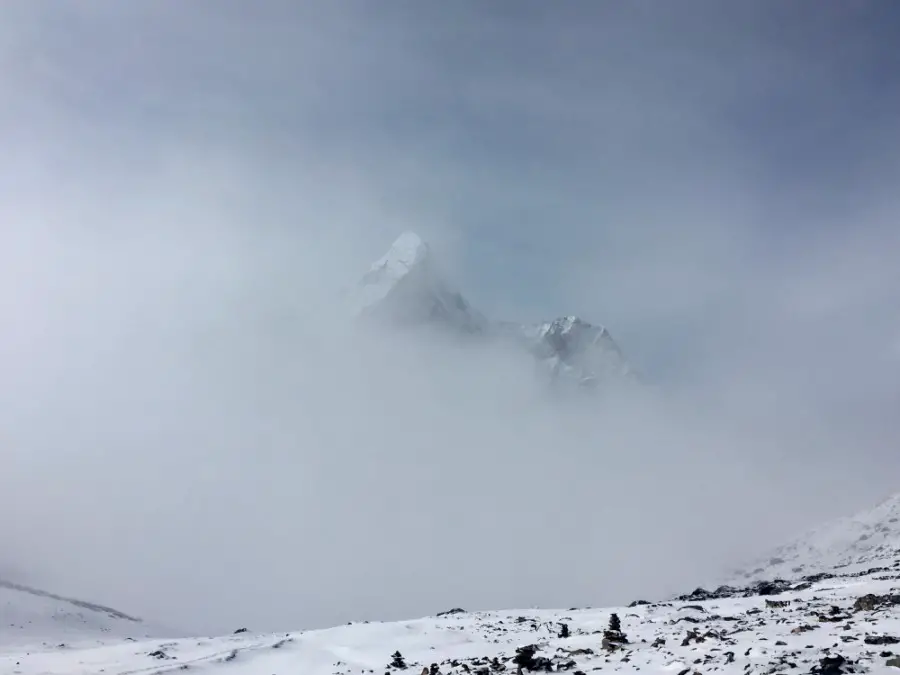
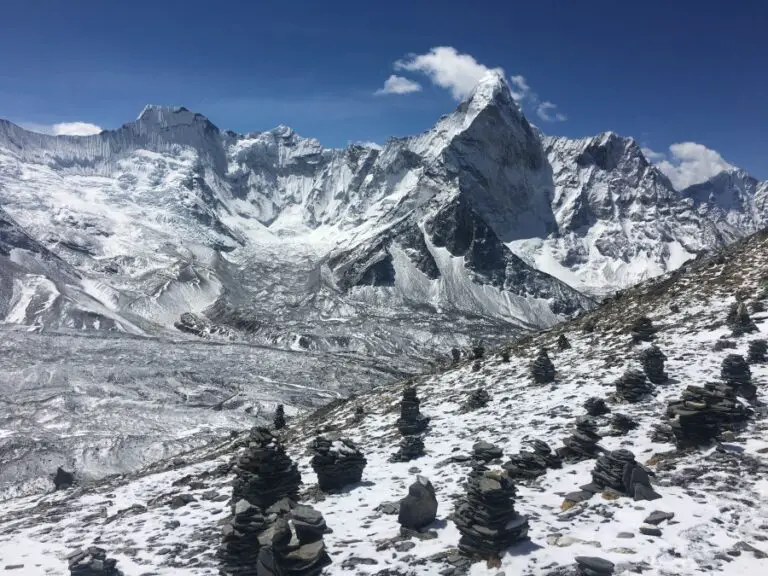
The round trip Chukhung Ri took me 4 hours. But you should know I turned back 100 meters from the main summit. The last bit of the hike is demanding. It was my birthday, so instead of struggling with the steep climb and breathing, I decided to head down to celebrate another beautiful year with a traditional Sherpa apple pie. The views from the pass below the summit were amazing enough to make my day.
Place to stay in Chukhung
After climbing Chukhung Ri, you can go back to Dingboche or stay overnight in Chukhung. If you choose the first option, it will be a very long trekking day. On the other hand, if you stay overnight in Chukhung and rest, you will pay the price the day after as the next day you will have to walk a lot.
It is worth staying in Chukhung just to spend the night at the Khangri Resort, the best lodge on my entire trek. Nice clean room with spotless toilet, soft carpets on the floor, sunny terrace, friendly staff and pleasant atmosphere makes it so great. The hot shower was not working because the water pipes were frozen over, but who cares at the altitude of 4,730m? Definitely not me. 🙂
DAY 9. Dingboche > Lobuche 4,920 m (9 km)
It is a very beautiful and interesting trekking day. After Dhugla, the trail goes through the Khumbu Glacier moraine. On the way, you’ll pass a cluster of very impressive chortens with colorful prayer flags, commemorating the death of climbers in the Khumbu region. This incredible, cementary-like place proves how dangerous Himalayan climbing is.
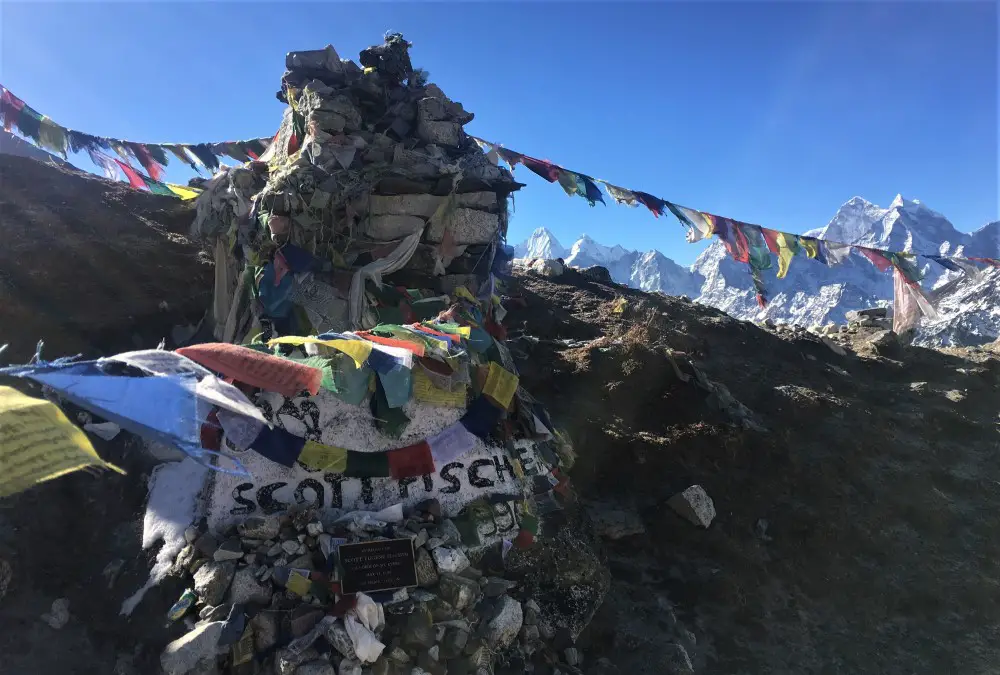
Practical tip
Stopping at Dughla (4,620 m) for a short break is a good idea. It is the last place before the main ascent to Lobuche. In case of any symptoms of altitude sickness, stay here overnight.
Place to stay in Lobuche
The mystery of why there was a mirror and a coat hanger in my room – two items considered luxurious at 4,910 m – was solved when I needed to pay my bill. Eco Himalayan Resort turned out to be very expensive. I paid 1100 NPR (~ 9.5 USD) for a room, while the standard room rate on the Everest Base Camp trek was 500 NPR so far (~ 4.5 USD).
DAY 10. Lobuche > Gorak Shep 5,140 m > EBC 5,364 m > Gorak Shep 5,140 m (12 km)
It’s a relatively long day, so you should start early. Despite the altitude – you are above 5,000 m – walking up to Gorak Shep can be very enjoyable if you are well-adapted to high altitude. At least it was for me. For the first hour the path is flat and you are surrounded by the stunning Khumbu glacier. The trail continues uphill, but the remarkable views, as well as the excitement of being so close to your final destination, make up for any physical effort.
Gorak Shep is the last settlement before the Everest Base Camp where most of the trekkers stay overnight. After finding a room, leave your backpack and have a meal, as you will need to continue your journey soon. The final approach to the base camp consists of numerous ascents and descents (about 2.5 – 3 hours one way).
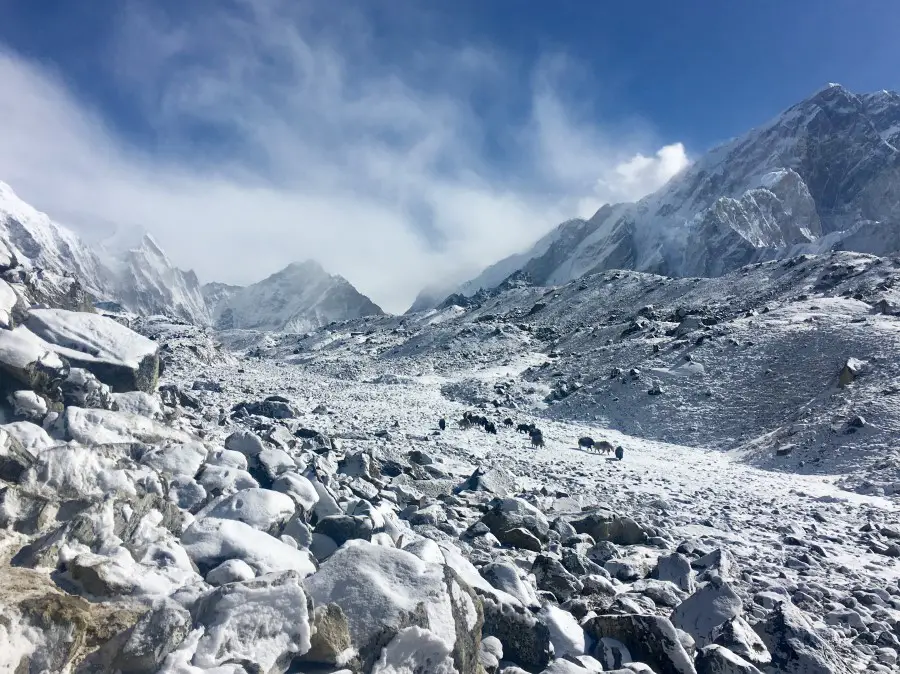
Many people claim that the Everest Base Camp trek is not worth the effort, because from the base you can not see the top of the highest mountain in the world, but only “some” tents. Reaching the base camp was a very emotional moment for me, one of my travel dreams came true. All Everest climbing expeditions start from here. This is where the adventure starts.
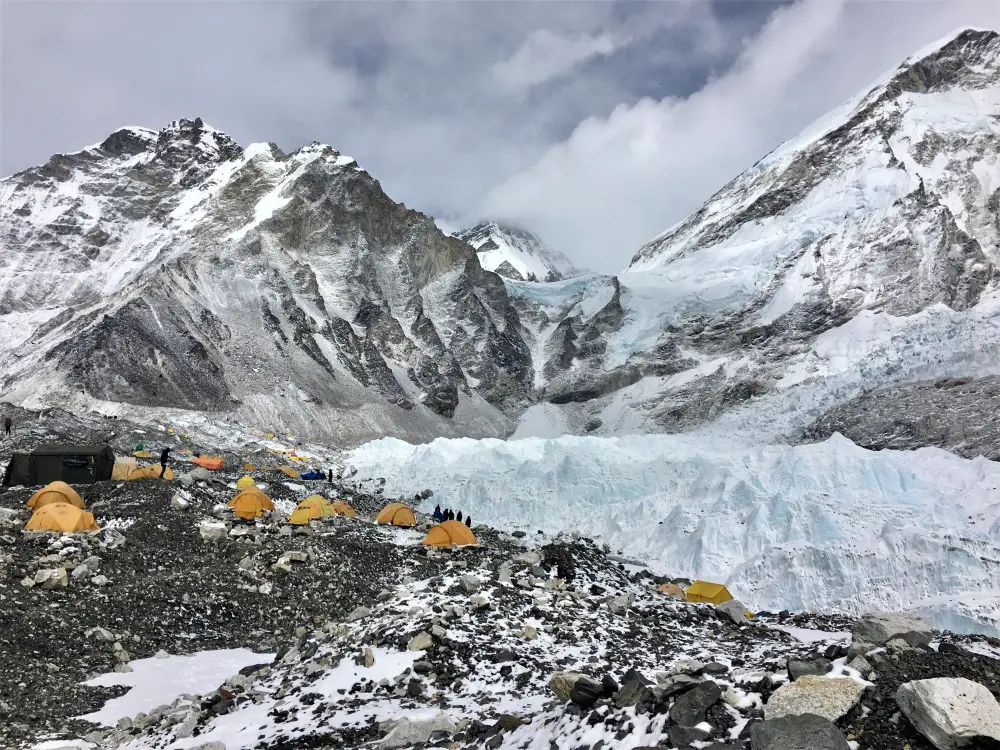
Practical tip
Numerous rescue helicopters flying over my head in the Khumbu Valley proved how important good acclimatization is and how severe the consequences of neglecting it can be. Extra days at Namche Bazaar, Pangboche or Dingboche are essential to prepare the body for high altitude.
Place to stay in Gorak Shep
For adventure lovers who are acclimatized and need very little to be happy in the mountains, Buddha Lodge in Gorak Shep may turn out to be a quite cozy option in this hostile land of eternal ice. Most people, however, sleep poorly in Gorak Shep, complaining about the cold and primitive conditions. At this altitude, especially at night, breathing becomes difficult making sleeping almost impossible. Without a proper sleeping bag, it can be terribly cold. But I was… hot! And if it wasn’t for my toothache, which is a good topic for another blog post, the night would have been very pleasant.
DAY 11. Gorak Shep > Kala Patthar 5,550 m > Lobuche 4,920 m (8.5 km)
To get the best view of the highest mountain in the world, climb Kala Patthar, which takes approximately 2 hours from Gorak Shep. The trail is well marked. Start early in the morning to enjoy the clear skies. Mount Everest likes to hide behind a cloud later in the day.
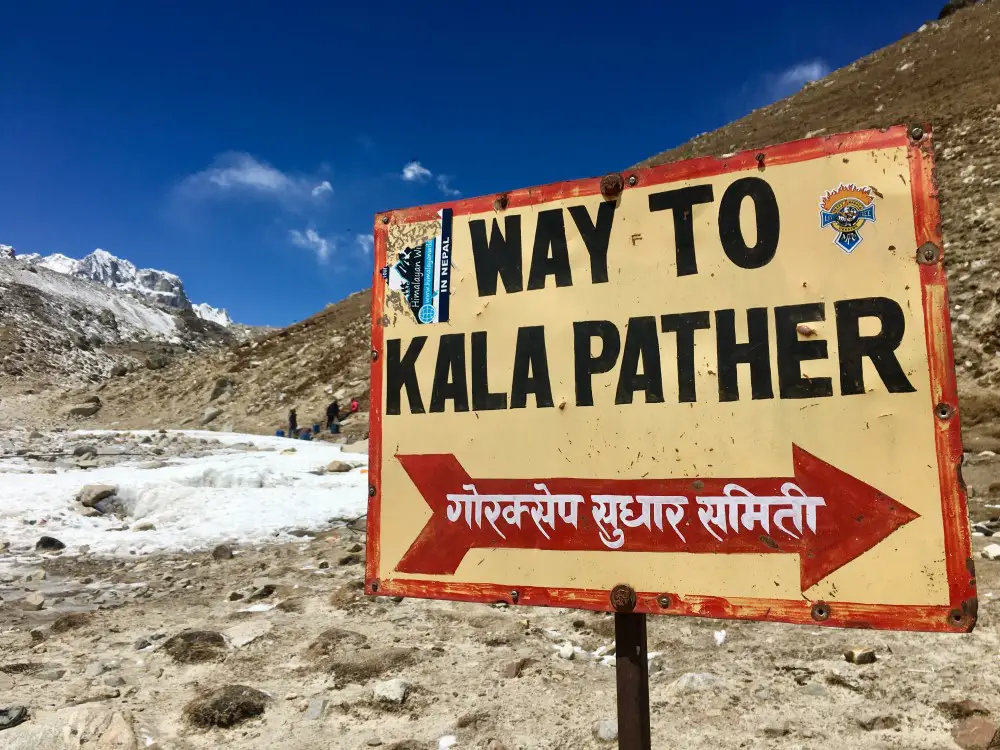
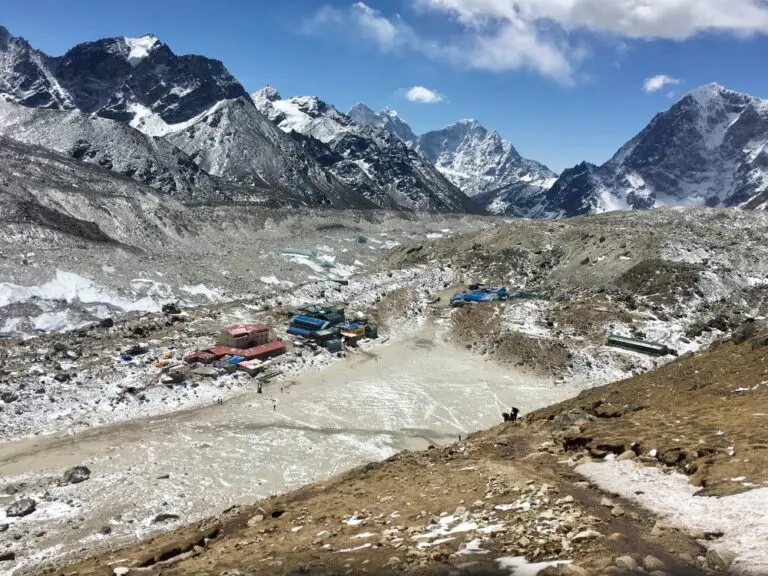
I thought I was in great shape and climbing to Kala Pattar would be a piece of cake, especially after leaving my heavy backpack in Gorak Shep. I couldn’t be more wrong. The ascent is steep and at this altitude each step is difficult. I walked at a snail’s pace. Well, trekking above 5,000 m is never an easy stroll. But… it was totally worth it though! The views were amazing. A 360-degree panorama of snow-capped peaks with Everest, Lhotse (8,516 m) and Pumori (7,161 m) made my heart beat faster. The return to Gorak Shep was much easier.
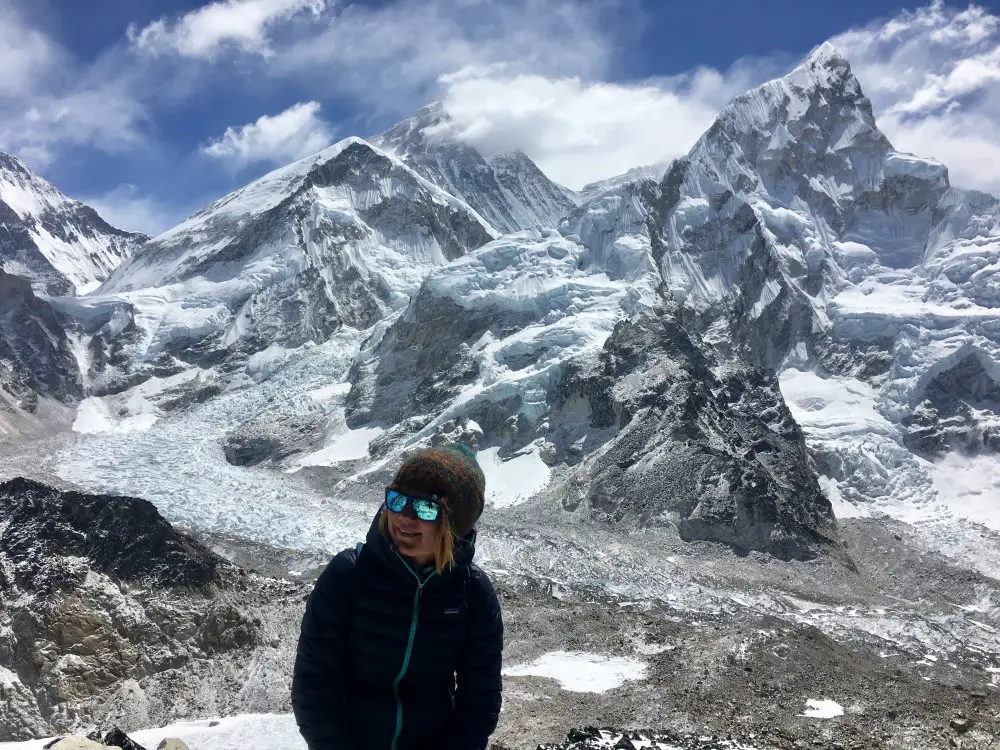
How far you can go depends on how tired you are. I don’t recommend spending the second night in Gorak Shep as it’s very high and cold, and one night spent at this altitude is more than enough. At least you should walk down to Lobuche, which is a little bit less high and cold. Some trekkers manage to go down to Pheriche or even Pangboche, but I was too tired for that. In any case, when going down to Lukla you do not have to follow any strict acclimatization rules, so where you stay for the night is entirely up to you. If you want to reach Lukla in less than 4 days you should walk the 7-km route from Lobuche to Pheriche.
Practical tip
Some people go to Kala Patthar before dawn to admire Everest in the rays of the rising sun. If you decide to do this, remember that it will be very cold and windy. Warm gloves, a decent down jacket and good boots are a must! Although I left Gorak Shep quite late – around 7 am, (I don’t like climbing in the dark and waking up in the middle of the night), it was still very cold. I can’t imagine how cold it is before dawn!
Place to stay in Lobuche
Oxygen Altitude is a better and cheaper option in Lobuche than the Eco Himalayan Resort where I stayed on my way up. A large and nice room with a great view cost 700 NPR (~ 6USD).
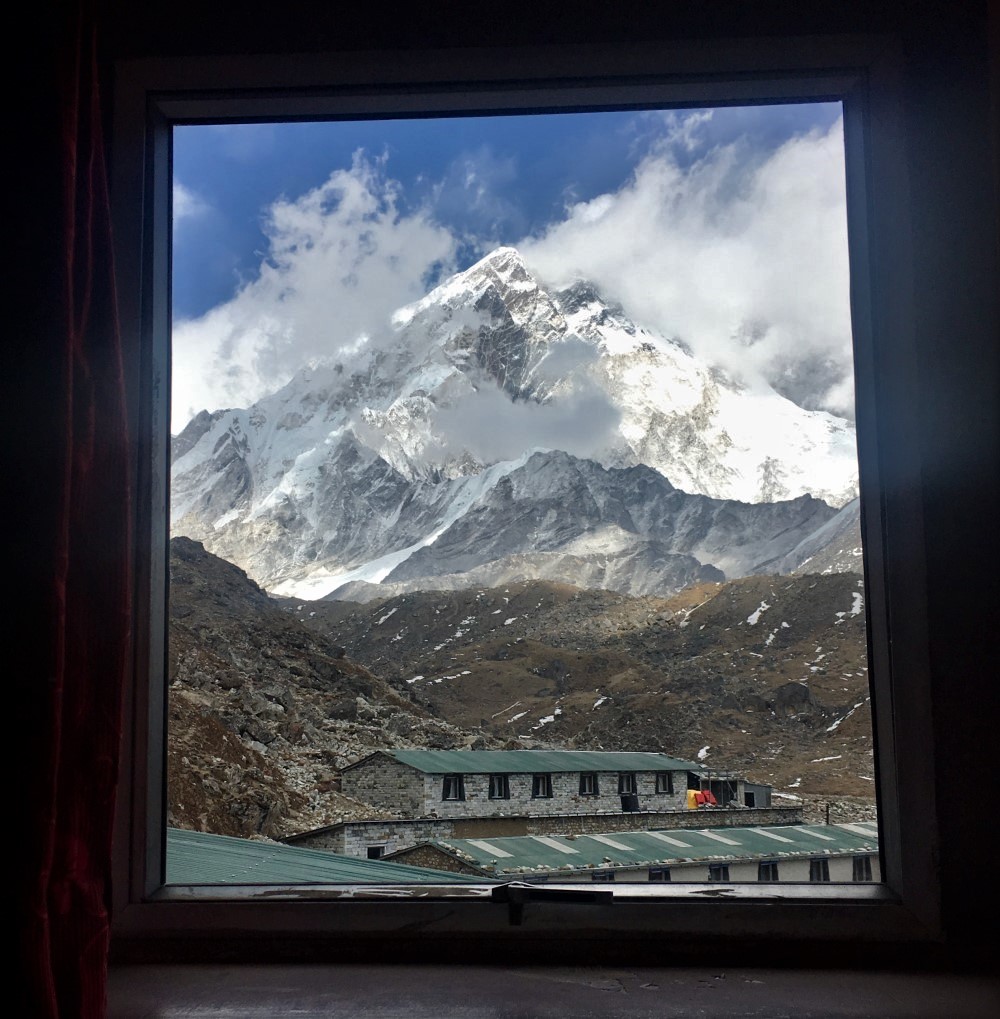
DAY 12. Lobuche via Pheriche > Deboche 3,820 m (16 km)
From Lobuche take a different, slightly shorter route down through Pheriche – less sunny and more windy village than Dingboche – but still a nice place to stay.
Many of the lodges, which were destroyed by the 2015 earthquake, have already been rebuilt in Pheriche. In addition, there is a characteristic cone-shaped sculpture – the Everest Memorial Sculpture – commemorating the names of climbers who died on the way to the summit. As you descend below 4,000 m, you will notice drastic changes in both the landscape and the climate. It’s not just snow, ice, gravel and stones anymore. It’s warmer, greener. A little bit of life appears. It feels so good.
I reached Deboche after a 7-hour walk. Surprisingly, I even had enough strength explore the female monastery, located near the main trail. If you had slept in Pheriche the day before, you might even be able to reach Namche today.
Practical tip
If you need any medical help on the Everest Base Camp trek, you should know there is a clinic in Pheriche. The majority of patients at the Himalayan Rescue Association Aid Post are those suffering from altitude sickness symptoms. But not only. I came with a toothache. I was immediately offered a tooth extraction by a friendly young doctor – an American volunteer. Refusing politely, I purchased some strong painkillers and I headed down.
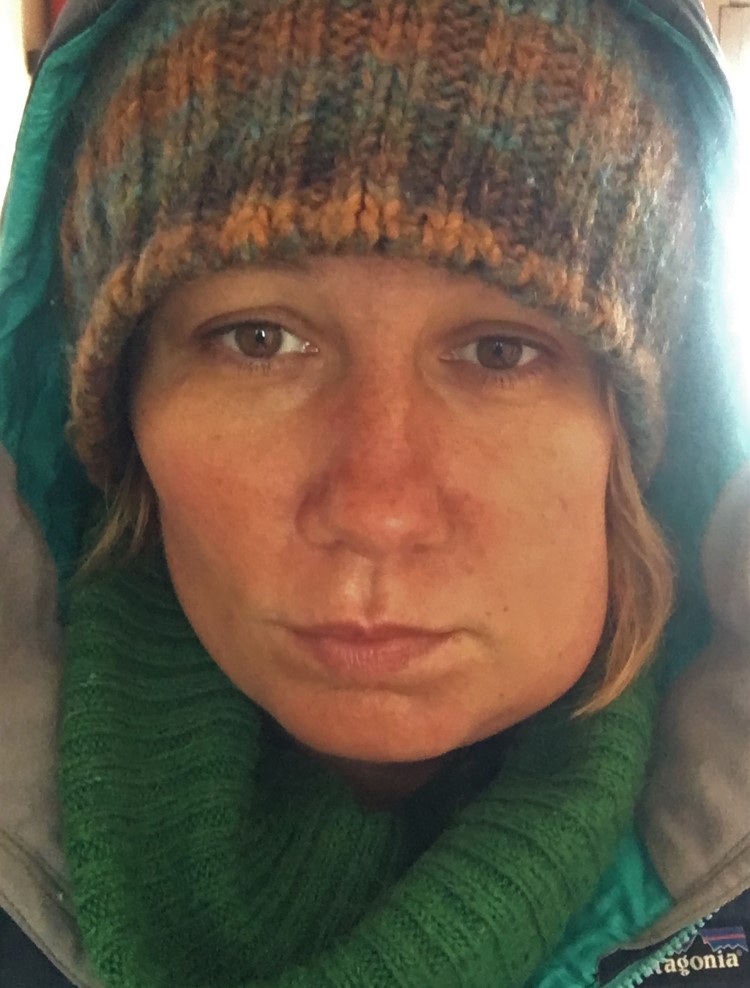
Place to stay in Deboche
The decision where to stay overnight depends on how far your legs will carry you. Personally, I think it’s nice to stay in different villages than the ones you stopped on your way up. I stayed at Deboche, at a pleasant Rivendell Lodge, popular with larger groups. The price of a room with a private bathroom was a staggering 3,000 NPR! (~ 25 USD) Luckily, rooms without a bathroom had a normal price of 500 NPR (~4.5 USD).
DAY 13. Deboche > Namche Bazaar 3,440 m (10 km)
Even though it was the same route as the one I went up, it didn’t bother me at all. On the contrary, it was fun to see certain places again. They all seemed familiar but very different at the same time.
The path, apart from 2 ascents – to Tengboche and after Phunki Thenga – leads down, which changes your perspective. If you have enough time, it’s nice to stay for the night in the bustling Namche Bazaar. If so, you can visit one of the cosy bars to celebrate over a beer or a glass of wine your successful trek. You don’t have to worry about acclimatization rules anymore! What a relief!
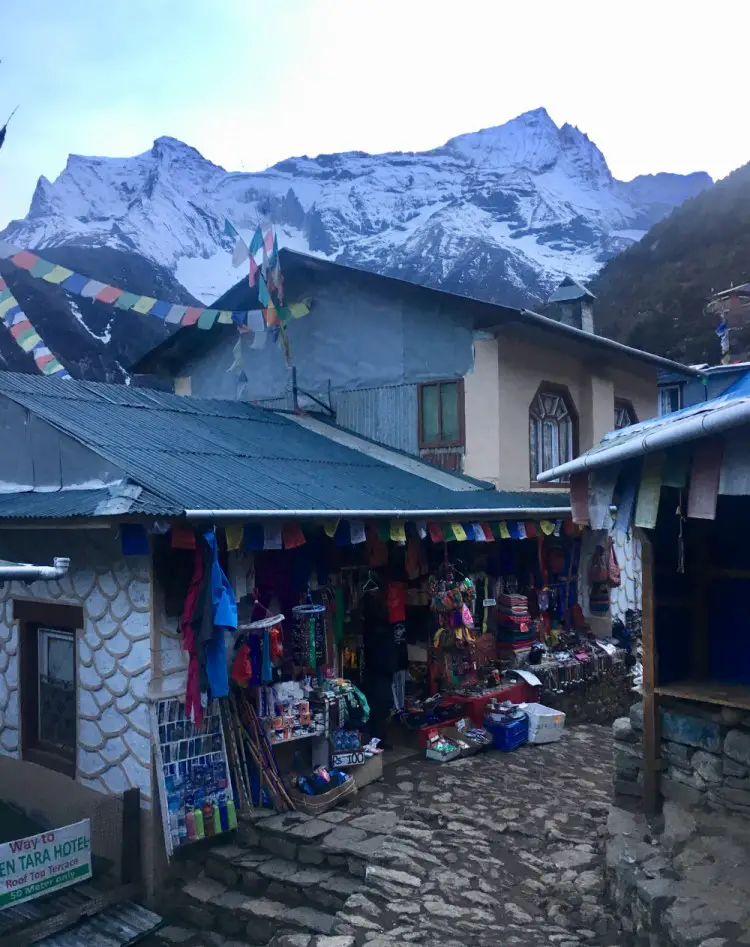
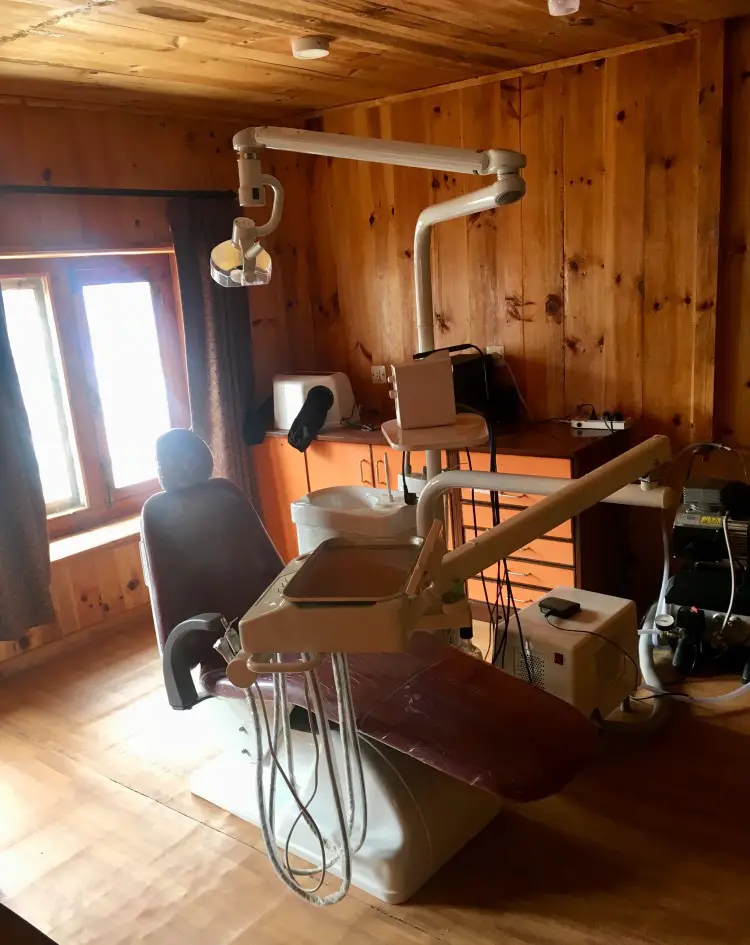
Place to stay in Namche Bazaar
Khumbu Lodge is probably the most famous and the oldest lodge in Namche Bazaar. Standard rooms (there are more luxurious options as well) may not have the most incredible views, but there is a well-functioning hot shower in the corridor and a very friendly atmosphere in the dining room, which is probably more important on the way back from the trek than beautiful views. Khumbu Lodge is a kind of institution in Namche. Many famous people as well as climbers whose tragic fate was described in Jon Krakauer’s extraordinary book “Into the Thin Air” stayed there.
DAY 14. Namche Bazaar > Lukla 2,840m (18km)
It’s incredible how hard it was to climb to Namche Bazaar, compared to how easy it was to go down. Along the way, I stopped at the very nicely decorated restaurant Mt. Kailash Lodge in Monjo for delicious and very fresh momo dumplings. Walking distance from Monjo to Lukla is long. A few ascents, which I completely forgot about, make the last day of the trek not so easy.
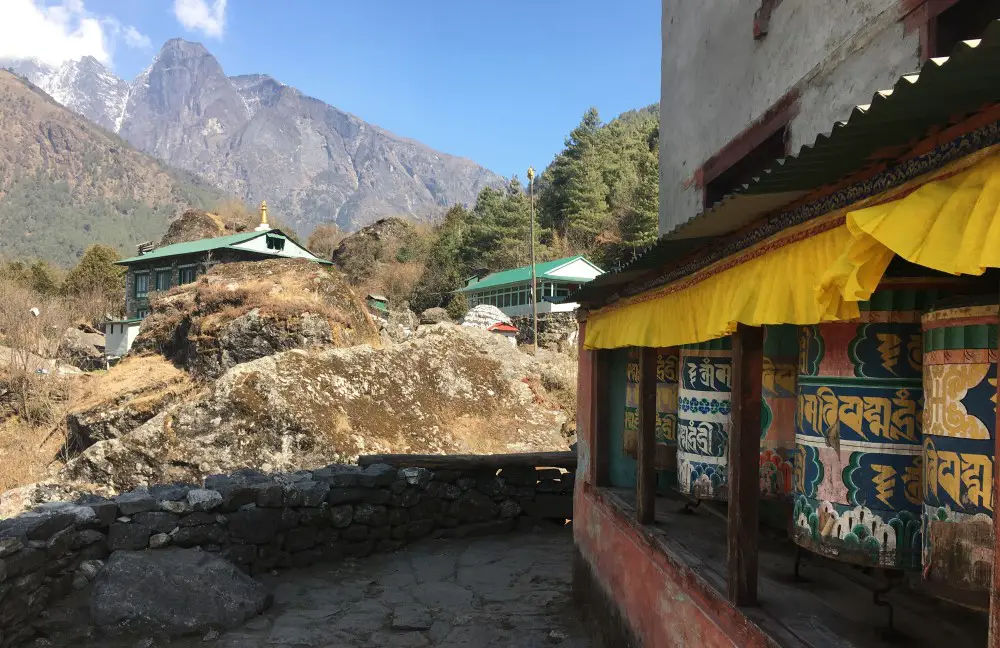
Practical tip
Similarly to your flight to Lukla, also on your way back it is best to take an early morning flight. The weather often deteriorates in the afternoon in Lukla.
If you leave Nepal immediately after your Everest Base Camp trek, you need to take into consideration a potential risk of flight delays and cancellations. It may happen that all flights from Lukla will be canceled for a few days. Do not plan to fly from Lukla the day before your international flight, but keep a safe time interval.
You can book your flight both online and through one of the agencies in Kathmandu, Sometimes tickets are even cheaper if you book through the agency. Usually, it is not a problem to change the departure date, if your trek ends earlier or is extended by a couple of days.
You can also, like me, leave the purchase of the ticket until the last minute after reaching Lukla. It’s also easy to buy it here. Just speak to the locals.
Place to stay in Lukla
Sunrise Hotel – the room didn’t smell too nice and the dining room was dark and uninviting. I didn’t like the atmosphere at all. Nevertheless, I chose to stay in this lodge because even though I arrived late, the owner was able to arrange for me a ticket for the morning flight to Kathmandu. The transaction was carried out in cash at the airport. It felt like a gangster movie. The price I paid was exactly the same as on the internet.
DAY 15. Lukla 2,840m > Kathmandu

Are you ready for your Everest Base Camp trek? I bet you are! Hope this blog post will help you with planning.
After writing this article I’m more than ready to return to the magical Himalayas as well. Climbing up to Ama Dablam and Everest Base Camp as well as to Chukhung Ri and Kala Patthar was not easy at all. It was cold and at high altitude breathing was a struggle, let alone carrying a backpack. But the views were incredible. Being so close to these incredible mountains makes you feel free, present and happy. It’s totally worth it. If I could, even now I would be teleported from from my comfy sofa into the icy Khumbu region.
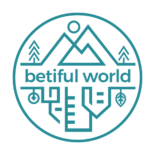
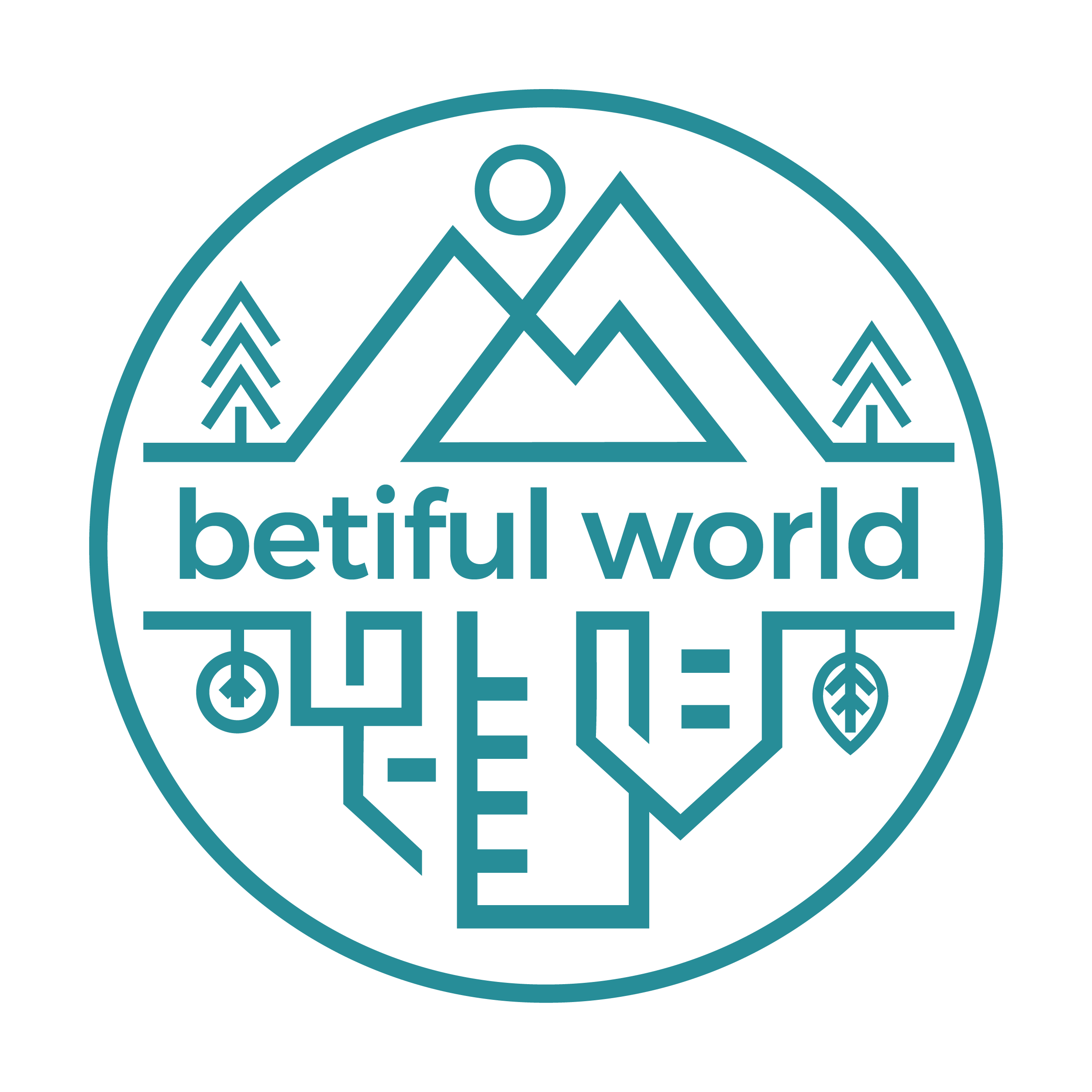






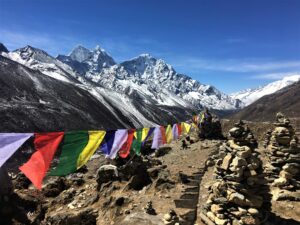
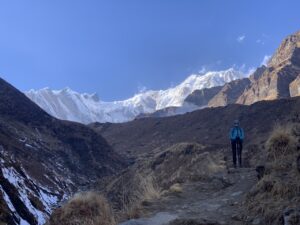
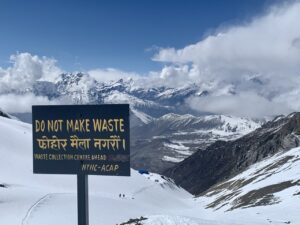
You say at day 12: “I think it’s nice to stay in different villages than the ones you stopped on your way up.”.
Even better is to go up a different ROUTE than coming down. Why walk the same trail twice when there is a better alternative?
Everybody should go up via Mong La. – Phortse – upper Pangpoche high trail instead of the standard up-and-down Tengboche. The views high up the valley side are the best on the whole trek, there is a lot of wildlife like musk deer and Himalayan tahr, and practically no other trekkers. It is amazing guides and agencies ignore this well constructed old trail between the ancient villages and just march their clients twice through Tengboche.
Thus alter the itinerary for days 4 and 5: day 4 lunch at Mong La (amazing place), overnight at Phortse where there are at least half a dozen big lodges. Day 5 hike to upper Pangpoche for lunch (about 3 hours), visit the 200 year old monastery and continue to Dingpoche using the higher trail, no need to walk the hotel strip of the lower village. Hike down via Tengboche either stopping there for a night or not.
I totally agree with you suggesting a different route than coming down. I will definitely take use of your comments during my next visit to the Khumbu region. I really appreciate sharing your ideas with me! My initial idea was to do both EBC and 3 passes trek and hence, do not go down the same way as the world is just too beautiful not to explore new paths. But the horrible toothache I got at the Base Camp ruined my plans and made me go down as quickly as possible, first to the clinic in Pheriche and then, to Namche to look for the dentist.
Beti
I have read so far only the first and second day and so far your tips are no less than excellent, thank you, and i’m looking forward to read it all! We are planning to take this trip next September. Are you willing to take a Q or 2 if I may have?
Thank you
Eytan
Hi Eytan, thank you so much! Sure please go ahead. I hope I can help. I can’t wait to return to Nepal myself 🙂
Hi Beti,
Your blog post is amazing, maybe the most detailed one i’ve ever read about Ebc trek. Firstly, thanks for this. I wondered that is it really possible to make it to the real Everest base camp, where the mountaniers stay? I heard that trekkers aren’t allowed to see there anymore and they can only access to a location nearby. Maybe you’ve seen the photos: a rock with a “Everest Base Camp 5364m” writing on it 🙂 I really want to see the real base camp with the yellow tents, at least from a distance. In your post, it seems that you’ve seen it like that, is it true? Or, is there something special to do to access that area? I’ll be in Nepal and walking ebc in a few weeks so your tips is very important to me.
I am so glad you like my blog post and so happy you go for this epic trek! Also, thank you for your nice comment 🙂 As far as I know you can still get to the famous Everest Base Camp rock, and of course you will see the yellow tents! Ordinary trekkers are not really welcomed to wander around the tents in the base camp (because of safety and health reasons) but you can see quite well the tents from a distance. I spent around half an hour sitting on my own in a quite corner and watching slow life in the EBC and how the tents were being set up in the base camp in April <3
Awesome report and practical source of information, huge thanks for it!
I enjoyed your AC blog…I just did the trip this last Feb…..Besishar thru Kagbeni, then due friend’s choice direct Tatopani. After reading your blog I was hoping there would be a similar ‘long version’ of the Everest trek….although I have done both treks about 5 times it is always good to see others’ experiences and learn some new things and of course it brings back good memories.
I have to admit though I was disappointed by the 12 day Lukla to Lukla itinerary….I was hoping for a comprehensive blog of a 3-4 week trek which is what I have always done with the full walk in or out etc. Did I miss something? Is there a full trek blog you did? TYhanks, Roger PS, I will be taking a ‘first timer’ to Nepal in Feb and will send your AC blog as well as the AC or EBC? blog to him for his edification….
Hello Roger! Thank you for reading and sharing my blog! If you’ve read my story of the trek to EBC, you should know that it ended earlier than planned due to the terrible toothache I had at EBC. I’m also very disappointed that I couldn’t continue hiking. But sometimes life doesn’t go according to plan. I really hope to return to Khumbu region soon and complete the 3-week EBC/3-passes trek and document it accordingly 🙂